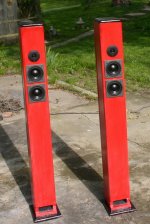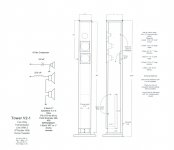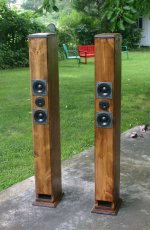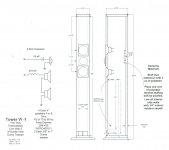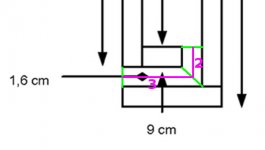KLB,
is your picture a jpg(jpeg), png or gif? Those are supported... maybe the format is different?
Should work if you follow this:
Reply to this by clicking the "Go Advanced" box.
Write whatever you need in the big box. Go lower and click on "Manage Attachments".
Another window will open.
Click on the "Choose File" box. Select the picture file in jpg, png or gif format. Click ok.
You will see the name of the file appear in the window. Now click on "Upload".
Go back to the main window... make sure the file you selected appears in the middle box called "Attach Files". If so, click "Submit Reply".
If the picture does not appear in this thread, it is because the picture format is not supported by this forum.
is your picture a jpg(jpeg), png or gif? Those are supported... maybe the format is different?
Should work if you follow this:
Reply to this by clicking the "Go Advanced" box.
Write whatever you need in the big box. Go lower and click on "Manage Attachments".
Another window will open.
Click on the "Choose File" box. Select the picture file in jpg, png or gif format. Click ok.
You will see the name of the file appear in the window. Now click on "Upload".
Go back to the main window... make sure the file you selected appears in the middle box called "Attach Files". If so, click "Submit Reply".
If the picture does not appear in this thread, it is because the picture format is not supported by this forum.
Those with an interest in the construction can go to my U Tube video at ;
https://youtu.be/DePndNej1x4 This was the original MTM version.
It has greater volume and a bit more bass.
https://youtu.be/DePndNej1x4 This was the original MTM version.
It has greater volume and a bit more bass.
Attachments
Modified Tabaq Speakers for TB W3-2141
Here are my Modified Tabaq speakers for TB W3-2141 drivers.



The discussions on the TB W3-2141 can be found in this thread -
http://www.diyaudio.com/forums/full-range/276429-new-fullranger-alert-tang-band-3-4-a.html
The details for the modifications that bjohannesen so kindly gave us can be found in Post #37.
IRONHANDS54 was the first to build his good-looking modified Tabaq speakers and he posted their pictures and comments in Post #68.
At the very outset I placed the speakers about 2 feet away from the wall. My initial listening opinion was that though these speakers had impressive sound quality, the bass level was a disappointment as I had expected so much more from them. The drivers had already undergone more than 150 hours of breaking-in, so for a moment I was left wondering whether I made some mistake during construction.
Then I moved the speakers up against the wall. That's when the true capabilities of these speakers stood out. The bass went deep, really deep - much lower than what the classic Tabaqs are capable of. The highs are clear, defined and controlled. The mids blend in well and the balance smooth and seamless throughout the frequency range - the overall effect is warm and relaxed. Its early days yet and I have to put the speakers through their paces in the coming weeks. To get the best out of these speakers, they should be placed near or against the wall and listened to on axis.
I also did a quick A-B comparison with the classic Tabaqs. I used a set of classic Tabaqs that double as test boxes and currently housing FaitalPro 3FE25 drivers. The difference is obvious and stark. To me the classic Tabaqs represent joyousness and fun. They are lively and bright. They have impressive bass too with the right drivers but do not go as low as the modified Tabaqs. On the other hand, the modified Tabaqs have good SQ and all-round balance which is warm and staid but relaxed.
Thank you Bjorn, for giving us yet another great design. Its so assuring that you and other stalwarts of DiyAudio are always there to support and encourage DIY'ers like us.
Here are my Modified Tabaq speakers for TB W3-2141 drivers.



The discussions on the TB W3-2141 can be found in this thread -
http://www.diyaudio.com/forums/full-range/276429-new-fullranger-alert-tang-band-3-4-a.html
The details for the modifications that bjohannesen so kindly gave us can be found in Post #37.
IRONHANDS54 was the first to build his good-looking modified Tabaq speakers and he posted their pictures and comments in Post #68.
At the very outset I placed the speakers about 2 feet away from the wall. My initial listening opinion was that though these speakers had impressive sound quality, the bass level was a disappointment as I had expected so much more from them. The drivers had already undergone more than 150 hours of breaking-in, so for a moment I was left wondering whether I made some mistake during construction.
Then I moved the speakers up against the wall. That's when the true capabilities of these speakers stood out. The bass went deep, really deep - much lower than what the classic Tabaqs are capable of. The highs are clear, defined and controlled. The mids blend in well and the balance smooth and seamless throughout the frequency range - the overall effect is warm and relaxed. Its early days yet and I have to put the speakers through their paces in the coming weeks. To get the best out of these speakers, they should be placed near or against the wall and listened to on axis.
I also did a quick A-B comparison with the classic Tabaqs. I used a set of classic Tabaqs that double as test boxes and currently housing FaitalPro 3FE25 drivers. The difference is obvious and stark. To me the classic Tabaqs represent joyousness and fun. They are lively and bright. They have impressive bass too with the right drivers but do not go as low as the modified Tabaqs. On the other hand, the modified Tabaqs have good SQ and all-round balance which is warm and staid but relaxed.
Thank you Bjorn, for giving us yet another great design. Its so assuring that you and other stalwarts of DiyAudio are always there to support and encourage DIY'ers like us.
Last edited:
If you want to use away from wall, the 1mH and 6.8R BSC will balance the sound so that it is as if it's against the wall, albeit at reduced sensitivity. Away from wall will give superior imaging and soundstage.
Thanks for the advice. I recall that you had recommended those little inductors for use in BSCs some pages behind in this thread. The type that you used doesn't seem to be available for the given value in any of the Indian online websites. Neither are regular 1 mH air core inductors.
I have some of these little green colour ferrite core toroid rings that I'd bought some time back. So I wound some coated copper wire to make my own inductors. 18 turns of 20 gauge (It's SWG in India) gave me 1 mH with DCR of 0.2 Ohms approximately. Cost came to less than 1 USD! I use low-power amps so I hope its going to work out alright.
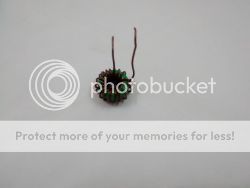
Last edited:
My own test with different drivers works best with a 3.9 resistor. This of course depends on your living room, listening distance, audio source and personal taste.
Bjørn
Thanks, Bjorn. I'll try that out too and try out the difference.
Dimensions for modelling TABAQ in Leonard TL Software
I'm currently trying to model the original TABAQ design using the Leonard TL software, so that I can adjust the design slightly.
I'm not sure about the dimensions to use in the model for the port. What I've got from the drawing so far is:
Section 1: 12.8cm x 10cm x 78 cm long
Section 2: 3.8cm x 10cm x 2cm long
Section 3: 1.6cm x 10cm x 12.1 cm long (open ended)
These lengths of sections 2 and 3 are calculated by taking a diagonal dividing line between the sections from the bottom corner of the port "shelf" piece to the back bottom corner of the cabinet. Are these section lengths correct for putting in to the simulation?
Thanks!
I'm currently trying to model the original TABAQ design using the Leonard TL software, so that I can adjust the design slightly.
I'm not sure about the dimensions to use in the model for the port. What I've got from the drawing so far is:
Section 1: 12.8cm x 10cm x 78 cm long
Section 2: 3.8cm x 10cm x 2cm long
Section 3: 1.6cm x 10cm x 12.1 cm long (open ended)
These lengths of sections 2 and 3 are calculated by taking a diagonal dividing line between the sections from the bottom corner of the port "shelf" piece to the back bottom corner of the cabinet. Are these section lengths correct for putting in to the simulation?
Thanks!
Attachments
Thanks for the advice. I recall that you had recommended those little inductors for use in BSCs some pages behind in this thread. The type that you used doesn't seem to be available for the given value in any of the Indian online websites. Neither are regular 1 mH air core inductors.
I have some of these little green colour ferrite core toroid rings that I'd bought some time back. So I wound some coated copper wire to make my own inductors. 18 turns of 20 gauge (It's SWG in India) gave me 1 mH with DCR of 0.2 Ohms approximately. Cost came to less than 1 USD! I use low-power amps so I hope its going to work out alright.

That's perfect - if you have an LCR meter it's the way to go. They are fine for low power. On larger >50w class speakers - they will saturate and sound funny but on a 5w speaker - you won't hear anything bad. It's amazing how low cost a DIY ferrite BSC can cost vs a commercial air core. It should work well.
TABAQ Geometry
Hi robskillz - and others!
I have enclosed the "master data" of TABAQ, which is a little different if you make reverse engineering from the construction plans.
I hope this will make it easier for anybody wanting to do their own adjustments or use it as inspiration for other designs.
Regards
Bjørn
Hi robskillz - and others!
I have enclosed the "master data" of TABAQ, which is a little different if you make reverse engineering from the construction plans.
I hope this will make it easier for anybody wanting to do their own adjustments or use it as inspiration for other designs.
Regards
Bjørn
Attachments
Thanks Bjoern! (Hope that spelling is OK for your name  I can do most accented letters on my keyboard but not the stroked-o
I can do most accented letters on my keyboard but not the stroked-o  )
)
It's interesting how the single port from the model is translated to physical dimensions. In the model it's 9.7cm long but that translates to 10.2cm + the back corner area. Does anyone know of a tutorial for folding TL's (and ports) and adjusting the modelled dimensions to work with corners?
It's interesting how the single port from the model is translated to physical dimensions. In the model it's 9.7cm long but that translates to 10.2cm + the back corner area. Does anyone know of a tutorial for folding TL's (and ports) and adjusting the modelled dimensions to work with corners?
Thanks Bjoern! (Hope that spelling is OK for your nameI can do most accented letters on my keyboard but not the stroked-o
)
Here's a trick for hard to find characters, like Bjørn's name.
Just use copy and paste. Copy his name from the post above, and paste it into your post.
In a folded line the length is measured in the center of the line all the way.
When constructing a cabinet from the model's internal measurements you sometimes make some small adjustments for practical reasons. Small deviations does not make much - if any - difference.
You still have tuning options like stuffing and BSC.
Bjørn
When constructing a cabinet from the model's internal measurements you sometimes make some small adjustments for practical reasons. Small deviations does not make much - if any - difference.
You still have tuning options like stuffing and BSC.
Bjørn
I am confused regarding ports and port lengths.
Everything I have read suggests that ports usually end up far shorter than the lengths calculated by any (!?) of the available box calculators.
What seems to be the case with Tabaq is that the port is far longer physically than calculated.
Clearly there is some voodoo magic going on that I have not mastered.
J.
Everything I have read suggests that ports usually end up far shorter than the lengths calculated by any (!?) of the available box calculators.
What seems to be the case with Tabaq is that the port is far longer physically than calculated.
Clearly there is some voodoo magic going on that I have not mastered.
J.
- Home
- Loudspeakers
- Full Range
- TABAQ TL for Tangband
